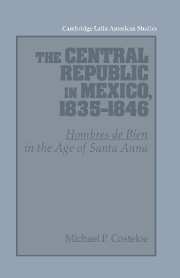Book contents
- Frontmatter
- Contents
- Preface
- Acknowledgements
- 1 An introduction: change and continuity in the Age of Santa Anna
- 2 The end of federalism
- 3 The transition to centralism: stage I
- 4 The transition to centralism: stage II
- 5 Las Siete Leyes
- 6 Anastasio Bustamante and the centralist republic, 1837–1839
- 7 Santa Anna versus Bustamante: the end of the Siete Leyes, 1839–1841
- 8 ‘La dictadura disfrazada con el hermoso nombre de regeneración política’
- 9 Santa Anna and the Bases Orgánicas
- 10 ‘La revolución de tres horas’
- 11 Herrera and the rise of Paredes y Arrillaga
- 12 Hombres de bien and the restoration of federalism
- 13 Conclusion
- Sources and works cited
- Index
- CAMBRIDGE LATIN AMERICAN STUDIES
8 - ‘La dictadura disfrazada con el hermoso nombre de regeneración política’
Published online by Cambridge University Press: 23 October 2009
- Frontmatter
- Contents
- Preface
- Acknowledgements
- 1 An introduction: change and continuity in the Age of Santa Anna
- 2 The end of federalism
- 3 The transition to centralism: stage I
- 4 The transition to centralism: stage II
- 5 Las Siete Leyes
- 6 Anastasio Bustamante and the centralist republic, 1837–1839
- 7 Santa Anna versus Bustamante: the end of the Siete Leyes, 1839–1841
- 8 ‘La dictadura disfrazada con el hermoso nombre de regeneración política’
- 9 Santa Anna and the Bases Orgánicas
- 10 ‘La revolución de tres horas’
- 11 Herrera and the rise of Paredes y Arrillaga
- 12 Hombres de bien and the restoration of federalism
- 13 Conclusion
- Sources and works cited
- Index
- CAMBRIDGE LATIN AMERICAN STUDIES
Summary
Unfortunately, we do not know what transpired inside the walls of the archbishop's palace at Tacubaya when Santa Anna, Paredes, Valencia, Cortazar and Tornel met around the table to construct the future political organization of the country. Whatever the mood or nature of the discussions, and Sra. Calderón implies that they were by no means amicable, Santa Anna emerged the victor. How he managed to impose his will, what deals were struck and promises made have still to be explained because the others present, notably Paredes and Valencia, were by no means lacking in personal ambition, as subsequent events were to demonstrate. The rumours of impending military autocracy had been current throughout the revolt against Bustamante, but Santa Anna was not the only potential candidate for the dictatorship. The others most often mentioned were precisely Paredes and Valencia, and it seems unlikely that they had agreed in advance that Santa Anna should emerge as the main beneficiary of their combined efforts. Escobedo had claimed in Guadalajara that Paredes had revealed his aim of dictatorship, and government propaganda had emphasized that this was the real objective. In contrast, Paredes, in discussions with Cortazar and the Guanajuato authorities early in September, apparently assured them that he was not seeking to establish a dictatorship, and it was on that basis that they joined the rebels. Later meetings, again called by Paredes, were held with representatives from the departments of Jalisco, Guanajuato, Zacatecas, San Luis Potosí, Querétaro and Aguascalientes.
- Type
- Chapter
- Information
- The Central Republic in Mexico, 1835–1846'Hombres de Bien' in the Age of Santa Anna, pp. 184 - 212Publisher: Cambridge University PressPrint publication year: 1993



